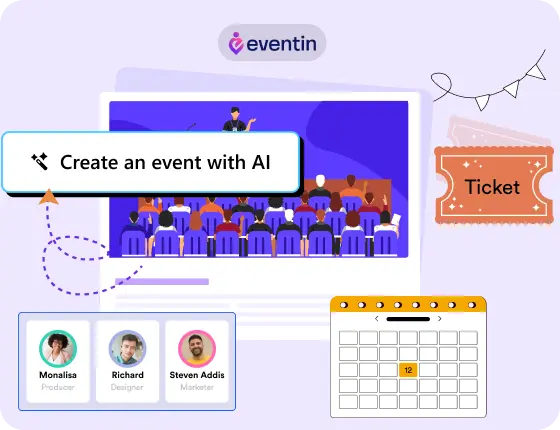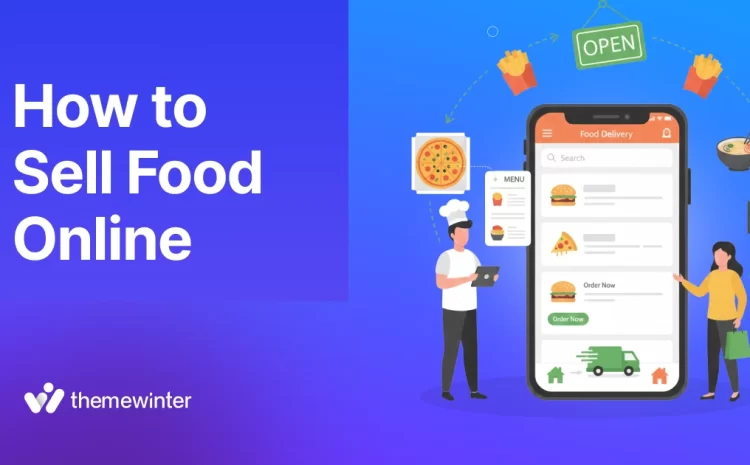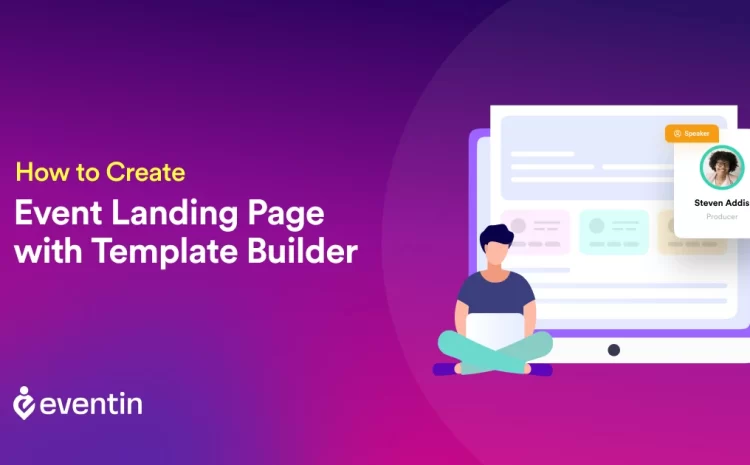How to Build an Event Marketing Funnel That Actually Works
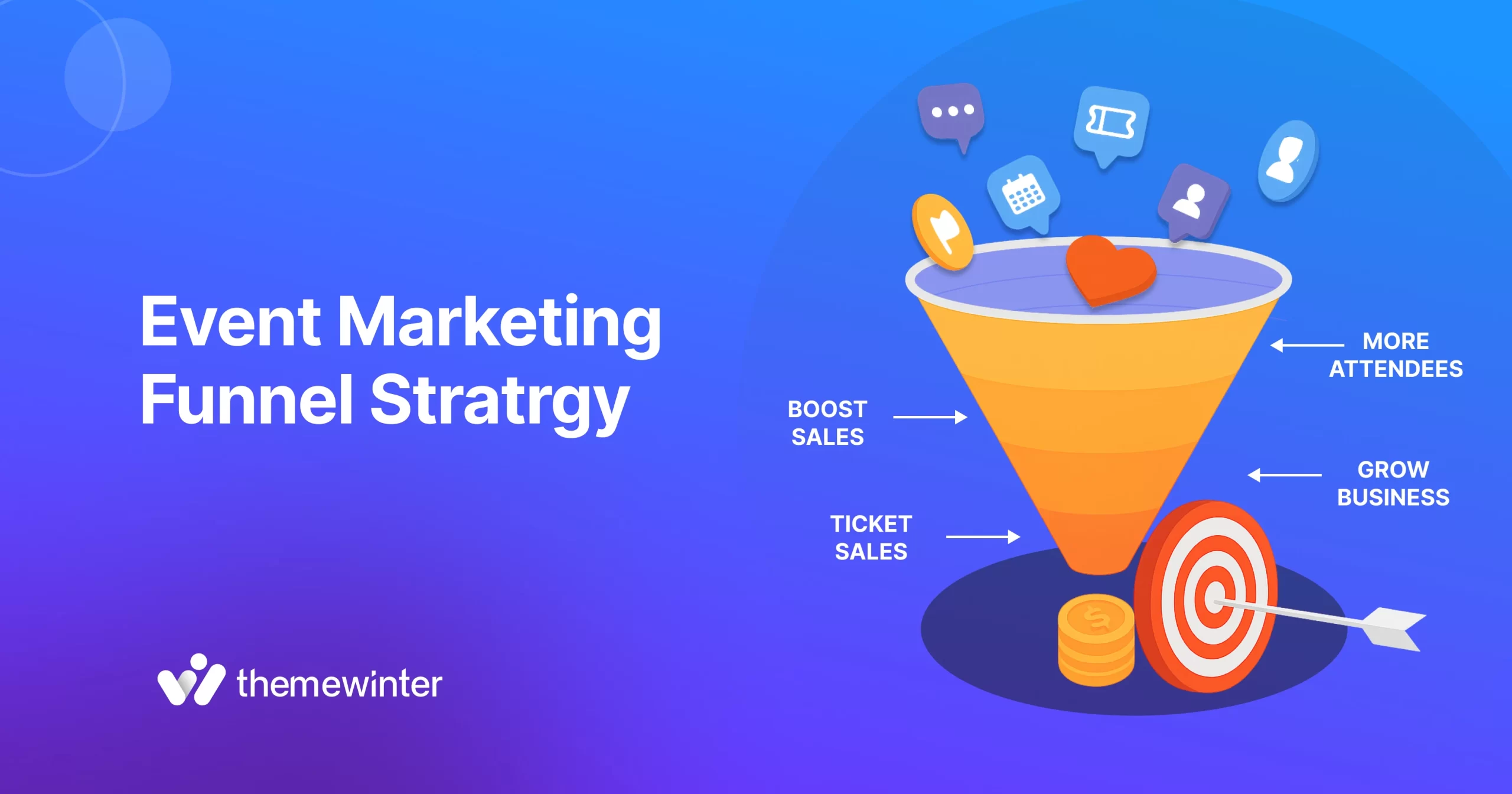
Table of Contents
An event looks like just a regular post on social media without a proper plan and strategy. Yes, it’s scrolled, skipped, and then? Forgotten.
But with a marketing funnel for your events, the game is totally different here. Yes, it lets you keep on the track from branding to promotion.
The result? Your event will not end up with just a few clicks or random registrations. Instead, you can guide your visitors and build a good relation for future marketing opportunities.
In this guide, we will learn in detail how a marketing funnel to reshape your event marketing strategy and provide you with a healthy foundation. So it becomes a revenue-generating source for your business.
📖 Keep reading…
What is an event marketing funnel, actually?
The event marketing funnel is the step-by-step path where people first hear about your event, to finally registering and even attending again in the future.
Think of it as a journey: at the top, you have a wide audience who has just discovered you.
As they move down the funnel, some drop off while others get more engaged—until the most interested ones reach the bottom and take action.
We all know about the marketing funnel stages. The process goes for same here.
- Attract the right audience
- Nurture their interest with the right messages
- Convert them into attendees or customers
Without a marketing funnel, you’re leaving this journey to chance. With one, you’re guiding people smoothly from awareness to commitment—making sure fewer slip through the cracks and more end up in your event seats.
📚 Related reading: How Eventin’s Free Features Save Your Time and Money — Here’s Everything You Can Do for $0 👉 Read more
How can a marketing funnel boost event growth?
A marketing funnel doesn’t just attract people—it builds momentum for your event. That’s where a marketing funnel makes all the difference.
Instead of relying on random promotions or hoping people show up, the funnel gives you a system that actually increases your growth.
Here’s how it helps:
- Brings in more of the right people – Your funnel spreads awareness in the places your audience actually hangs out, so you’re not wasting time chasing the wrong crowd.
- Keeps interest alive – Most people don’t register the first time they see your event. A funnel gives you touchpoints—emails, posts, reminders—that keep them engaged until they’re ready.
- Boosts conversions – Clear steps, strong calls-to-action, and timely offers help turn curious visitors into paying attendees.
- Encourages repeat attendance – A funnel doesn’t end at ticket sales. By following up and building loyalty, you turn one-time guests into regulars who bring friends along next time.
Basically, a funnel doesn’t just fill seats for one event—it creates a cycle where every event supports the next event. That’s how small events grow into sold-out shows and lasting communities.
📚 Related reading: Google AI Overviews & Events: How to Format Your Event Page so Google Quotes You 👉 Read more
5 steps to create an event marketing funnel for maximum engagement
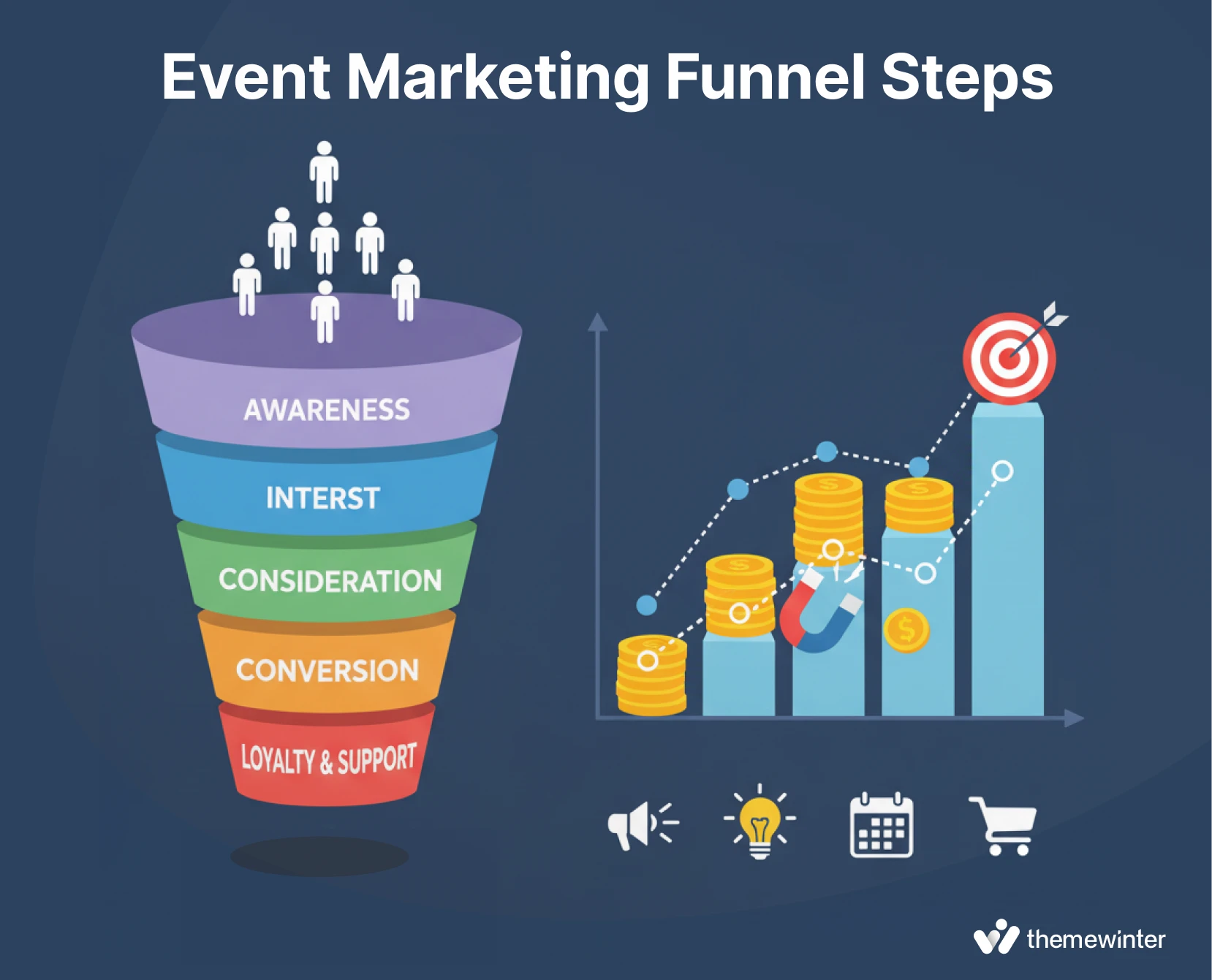
Building a funnel might sound complex, but it’s really just about guiding people step by step until they’re ready to join your event—and making sure they come back for the next one.
Here’s how it works:
Stage 1: Awareness – Create hype and get into the user’s mind
This is where everything begins. If people don’t know about your event, they won’t show up.
Your goal here is to make a hype and reach as many relevant people as possible. Strong visuals, short messages, and consistent presence help you get noticed.
What to do:
- Start with a simple event page that explains the basics: date, place, and why it’s worth attending.
- Use social media posts, run ads, and do partnerships to reach more people
- Share teasers, countdowns, or behind-the-scenes clips to build curiosity.
- Get listed in event directories or local calendars so people searching for events can find you.
What to avoid:
Don’t try to sell tickets right away—people aren’t ready yet. Make sure you do not post once and then leave the forum. Continue to advertise your events as much as you can.
Stage 2: Interest – Engage your potential attendees
Now that people know your event exists, you need to spark genuine interest. This is about moving them from “I’ve seen it” to “This looks worth my time.”Share event details, introduce speakers, and send updates to keep your event top of mind.
What to do:
- Give them details: introduce speakers, sessions, or activities.
- Share short videos, blog posts, or stories that highlight what makes your event different.
- Collect email sign-ups with a “Get updates” or “Join the list” option.
- Send regular but helpful emails—like agenda previews, exclusive content, or early offers.
What to avoid:
Don’t overload people with long, boring content. Avoid generic posts that don’t connect with your audience. Skipping engagement (like replies or Q&A sessions) makes you forgettable.
📚 Related reading: Never Miss a Beat: Your Ultimate 10‑Step Event Planning Checklist (Pre‑, On‑, Post‑Event) 👉 Read more
Stage 3: Consideration (Evaluation) – Ease the user’s decision with your presentation
Here, potential attendees are deciding: Should I really attend this event? They might compare your event with others or weigh the cost vs. value. Make the value clear and remove doubts by showing benefits, testimonials, and offering incentives.
What to do:
- Show the value clearly: networking opportunities, skills they’ll learn, or experiences they won’t find elsewhere.
- Share testimonials, reviews, or highlights from past events.
- Add an FAQ section to your page to remove doubts (cost, travel, online access, etc.).
- Offer deals like early-bird pricing or group discounts to encourage action.
What to avoid:
Don’t ignore objections—like price, travel, or timing. Avoid hiding costs or leaving out important info. Confusing messaging or overpromising can break trust and stop conversions.
Stage 4: Conversion – It’s time to seal the deal (Registration/Purchase)
This is where people register or buy tickets. Make the process fast, simple, and mobile-friendly. Every step should lead them closer to confirming their spot at your event.
What to do:
- Keep the registration form short and simple.
- Make sure the process works on mobile and desktop.
- Use strong, clear calls-to-action like “Register Now” or “Save Your Seat.”
- Send an instant confirmation email with all event details and a calendar link.
What to avoid:
Don’t make registration complicated. Avoid long forms, hidden fees, or slow-loading pages. A clunky process will cause drop-offs and wasted ad spend.
Stage 5: Loyalty & Support – Post-event follow-up
The marketing funnel doesn’t stop once the event ends. Loyal attendees can become your biggest promoters for future events.
After the event, keep the relationship alive. Thank attendees, share highlights, and ask for feedback. Happy guests turn into repeat attendees and event promoters.
What to do:
- Send a thank-you email after the event with photos, recordings, or highlights.
- Ask for quick feedback through a short survey.
- Share event moments on social media and encourage attendees to share theirs.
- Offer loyalty perks: discounts for the next event, early access tickets, or a private group.
What to avoid:
Don’t vanish after the event. Ignoring attendees means losing future sales. Avoid long delays in follow-up, skipping feedback requests, or failing to reward loyal attendees.
📚 Related reading: How to Convert an Event Management Website Into a Multi-Vendor Marketplace 👉 Read more
Conclusion: Let’s win the game with a smart event funnel strategy
Events don’t grow on hope—they grow when you guide people step by step. A smart event marketing funnel helps you attract the right audience, keep them engaged, and turn them into loyal supporters. From awareness to loyalty, every stage matters.
If you put this funnel into action, you’ll not only fill seats—you’ll build lasting connections that make each event stronger than the last.
🎁 Wait, I have something to tell you! (Bonus)
If you understand the event marketing funnel strategy but struggle to run a complete event—where you can manage everything in one place and sell tickets easily—then you should try Eventin Event Manager.
You can generate completed events in 3 minutes with this WordPress event plugin. In addition, you can collect attendee details on registration forms, offer multi-tiered ticket pricing, secure payment gateways, a custom ticket builder, and automate confirmation emails for your events for FREE!
Frequently asked questions (FAQs)
Q1. Why do I need a marketing funnel for my event?
Without a funnel, your event promotion is scattered and unpredictable. A funnel creates a clear system to capture attention, build trust, and drive registrations—ensuring your seats don’t stay empty.
Q2. How does an event marketing funnel help boost event growth?
It expands your reach, nurtures interest, increases ticket sales, and encourages repeat attendance. With the right marketing funnel, your events can grow consistently instead of relying on one-off promotions.
Q3. What’s the easiest way to sell tickets online?
The simplest way is to use an event management tool that handles ticket sales directly on your website. Eventin lets you create tiered pricing, offer discounts, and accept payments securely—no third-party checkout needed.
Q4. Can I build an event marketing funnel without tools?
Yes, but it will be time-consuming and harder to track. Using an event management tool like Eventin makes it easier to manage promotions, registrations, and follow-ups in one place.
Q5. Do I need a big budget to set up a funnel?
Not at all. You can start small with free event management tools and social media.
